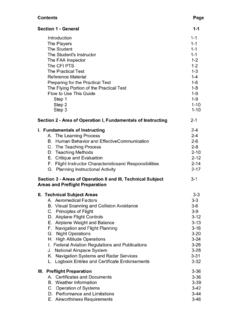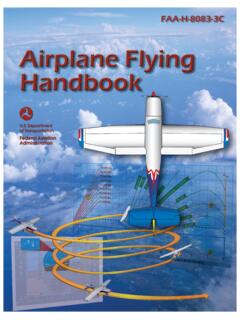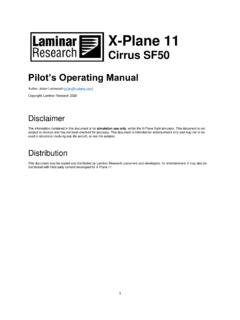Transcription of Chapter 7 Airport Traffic Patterns
1 Chapter 7. Airport Traffic Patterns Introduction Airport Traffic Patterns are developed to ensure that air Traffic is flown into and out of an Airport safely. Each Airport Traffic pattern is established based on the local conditions, including the direction and placement of the pattern, the altitude at which it is to be flown, and the procedures for entering and exiting the pattern. It is imperative that pilots are taught correct Traffic pattern procedures and exercise constant vigilance in the vicinity of airports when entering and exiting the Traffic pattern. Information regarding the procedures for a specific Airport can be found in the Chart Supplements. Additional information on Airport operations and Traffic Patterns can be found in the Aeronautical Information Manual (AIM).
2 7-1. Airport Traffic Patterns and Operations A pilot is not expected to have extensive knowledge of all Traffic Patterns at all airports, but if the pilot is familiar Just as roads and streets are essential for operating with the basic rectangular pattern, it is easy to make proper automobiles, airports or airstrips are essential for operating approaches and departures from most airports, regardless airplanes . Every flight begins and ends at an Airport or other of whether or not they have control towers. At airports with suitable landing field; therefore, it is essential that pilots learn operating control towers, the tower operator can instruct the Traffic rules, Traffic procedures, and Traffic pattern layouts pilots to enter the Traffic pattern at any point or to make a that may be in use at various airports.
3 Straight-in approach without flying the usual rectangular pattern. Many other deviations are possible if the tower When an automobile is driven on congested city streets, it operator and the pilot work together in an effort to keep Traffic can be brought to a stop to give way to conflicting Traffic ;. moving smoothly. Jets or heavy airplanes will frequently however, an airplane can only speed up, climb, descend, and be fly wider and/or higher Patterns than lighter airplanes , and slowed down. Consequently, Traffic Patterns and Traffic control in many cases, will make a straight-in approach for landing. procedures have been established for use at airports. Traffic Patterns provide procedures for takeoffs, departures, arrivals, Compliance with the basic rectangular Traffic pattern reduces and landings.
4 The exact nature of each Airport Traffic pattern the possibility of conflicts at airports without an operating is dependent on the runway in use, wind conditions (which control tower. It is imperative that a pilot form the habit of determine the runway in use), obstructions, and other factors. exercising constant vigilance in the vicinity of airports even when the air Traffic appears to be light. Midair collisions Control towers and radar facilities provide a means of usually occur on clear days with unlimited visibility. Never adjusting the flow of arriving and departing aircraft and assume you have found all of the air Traffic and stop scanning. render assistance to pilots in busy terminal areas. Airport lighting and runway marking systems are used frequently to Figure 7-1 shows a standard rectangular Traffic pattern.
5 Alert pilots to abnormal conditions and hazards so arrivals The Traffic pattern altitude is usually 1,000 feet above the and departures can be made safely. elevation of the Airport surface. The use of a common altitude at a given Airport is the key factor in minimizing the risk of Airports vary in complexity from small grass or sod strips collisions at airports without operating control towers. to major terminals with paved runways and taxiways. Regardless of the type of Airport , a pilot must know and abide When operating in the Traffic pattern at an Airport without an by the rules and general operating procedures applicable to operating control tower, the pilot should maintain an airspeed the Airport being used. The objective is to keep air Traffic of no more than 200 knots (230 miles per hour (mph)) as moving with maximum safety and efficiency.
6 Information required by Title 14 of the Code of Federal Regulations (14. on Traffic Patterns and operating procedures for an Airport CFR) part 91. In any case, the pilot should adjust the airspeed, is documented in the Chart Supplements, as well as visual when necessary, so that it is compatible with the airspeed of markings on the Airport itself. The use of any Traffic the other airplanes in the pattern. pattern, service, or procedure does not diminish the pilot's responsibility to see and avoid other aircraft during flight. When entering the Traffic pattern at an Airport without an operating control tower, inbound pilots are expected to Standard Airport Traffic Patterns observe other aircraft already in the pattern and to conform to To assure that air Traffic flows into and out of an Airport in an the Traffic pattern in use.
7 If there are no other aircraft present, orderly manner, an Airport Traffic pattern is established based the pilot should check Traffic indicators on the ground and on the local conditions, to include the direction and altitude wind indicators to determine which runway and Traffic pattern of the pattern and the procedures for entering and leaving the direction to use. [Figure 7-2] Many airports have L-shaped pattern. Unless the Airport displays approved visual markings Traffic pattern indicators displayed with a segmented circle indicating that turns should be made to the right, the pilot adjacent to the runway. The short member of the L shows should make all turns in the pattern to the left. the direction in which the Traffic pattern turns are made when using the runway parallel to the long member.
8 The When operating at an Airport with an operating control tower, pilot should check the indicators from a distance or altitude the pilot receives a clearance to approach or depart, as well well away from any other airplanes that may be flying in the as pertinent information about the Traffic pattern by radio. If Traffic pattern. Upon identifying the proper Traffic pattern, there is not a control tower, it is the pilot's responsibility to the pilot should enter into the Traffic pattern at a point well determine the direction of the Traffic pattern, to comply with clear of the other airplanes . the appropriate Traffic rules, and to display common courtesy toward other pilots operating in the area. 7-2. Crosswind D. Entry IN. W. 18. Left-Hand Traffic Pattern Downwind Departure 36.
9 Base Final Crosswind Entry W. I. N. D. 18. Right-Hand Traffic Pattern Downwind Departure 36. Final Base Figure 7-1. Traffic Patterns . When approaching an Airport for landing, the Traffic pattern is leg. Entries into Traffic Patterns while descending create normally entered at a 45 angle to the downwind leg, headed specific collision hazards and should always be avoided. toward a point abeam the midpoint of the runway to be used for landing. When arriving, the pilot should be aware of the The pilot should ensure that the entry leg is of sufficient proper Traffic pattern altitude before entering the pattern and length to provide a clear view of the entire Traffic pattern remain clear of the Traffic flow until established on the entry 7-3.
10 With another aircraft that is already established on the final Traffic pattern indicators (indicates location of base leg) approach. Pilots must not attempt an overly steep turn to final, especially uncoordinated! If in doubt, go around. The final approach leg is a descending flightpath starting from the completion of the base-to-final turn and extending to the point of touchdown. This is probably the most important leg of the entire pattern, because of the sound judgment and precision required to accurately control the airspeed and descent angle while approaching the intended touchdown point. Windsock 14 CFR part 91, states that aircraft, while on final approach to land or while landing, have the right-of-way over other aircraft in flight or operating on the surface.















